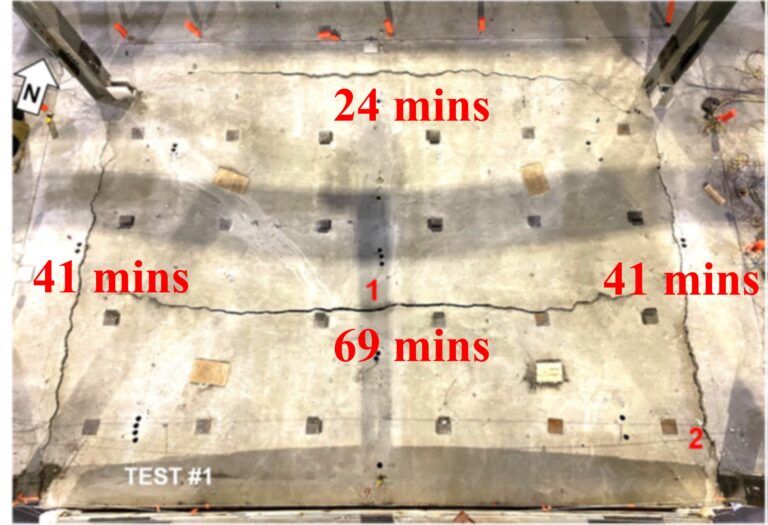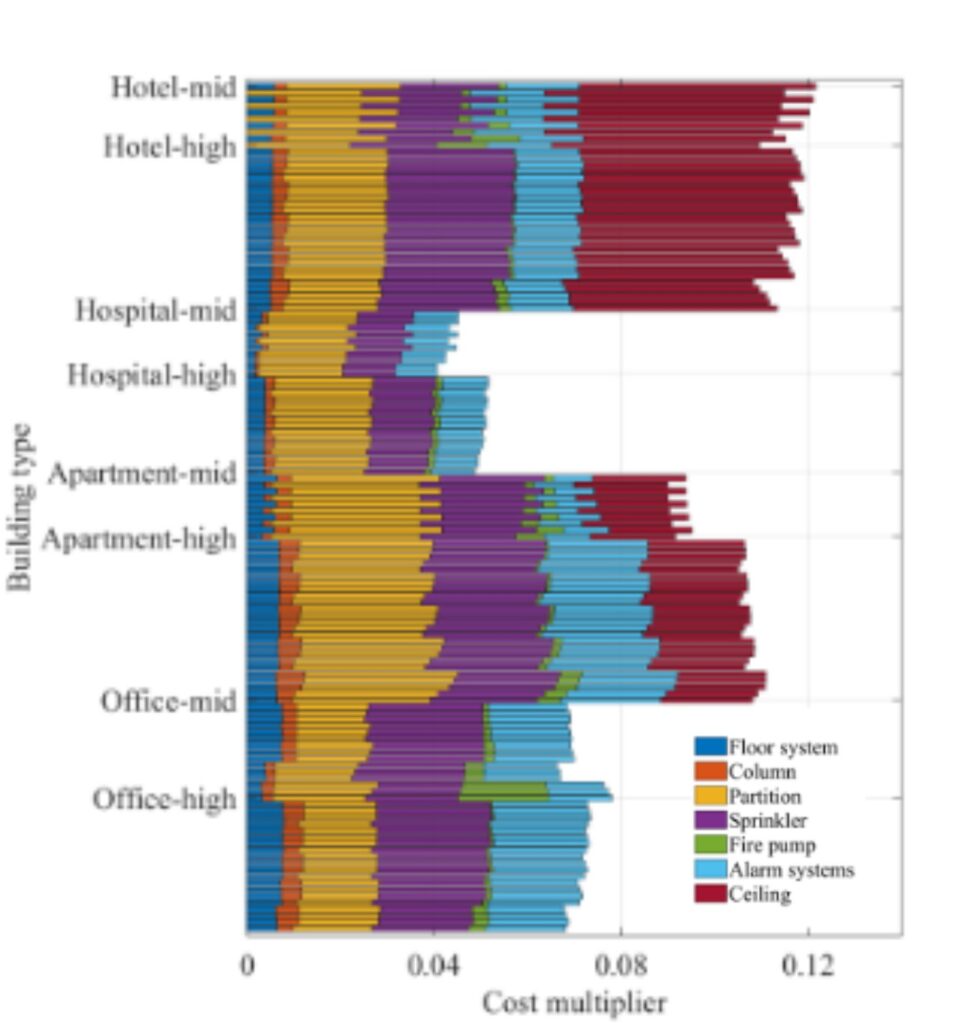Resources
NIST test data
Full-scale composite floor system fire tests
The NIST conducted three fire experiments on full-scale steel-concrete composite structures. The test specimens were loaded and subjected to the ASTM E119 fire. The baseline floor specimen (Test 1) was designed for a 2-hour fire rating. The two other experiments aimed at testing alternative designs of the floor system, with variation in fire protection of the steelwork and on amount of steel reinforcement in the composite slab.

Test #1 served to evaluate the performance of a floor assembly designed according to the currently applicable prescriptive provisions for a 2-hour fire resistance rating in the US. All primary and secondary beams were protected with a thickness of SFRM based on the UL ratings. These fire protection thicknesses were derived from standardized testing according to ASTM E119. The steel reinforcement area in the slab was 60 mm2/m. The connections were over-sprayed with an SFRM thickness of at least 25 mm.
Integrity failure happened about 90 mins, and the test stopped at 106 mins. This design thus fails to meet the 2 hr requirement.

Test #2 is the same as Test #1 except the slab reinforcement, which was increased from 60 mm2/m (welded wire in S755) to 230 mm2/m (no. 3 bars in S480) to investigate the influence of slab reinforcement on structural integrity.
The structure survived the fire with no integrity failure until the end of the cooling phase.

Test #3 investigated the response of the assembly with unprotected secondary beam. Compared with Test #2, no SFRM was applied on the central beam in the compartment and its end connections. This allowed investigating the effect of tensile membrane action of the floor as a resisting mechanism.
The structure survived the target 2-hour ASTM E119 fire exposure. The first major crack was observed after 132 mins.
Numerical modeling of the NIST tests

Construction costs database
To facilitate the construction cost estimation, we developed a cost database is for 130 prototypes of steel framed composite buildings with different occupancies, dimensions, and fire ratings. The data was obtained from a commercial cost estimator. The cost of passive fire protection on steelwork is found to range from 0 to 1.20% of the total construction cost for composite buildings with sprayed fire resistive material in the United States. The total cost of fire safety measures (including active measures such as sprinklers) ranges between 4% and 12% of the total construction cost in composite buildings.

Fragility curves database
Results show that the performance-based design using tensile membrane action has a higher probability of moderate damage but a lower probability of integrity failure than the prescriptive design. Parametric analyses show that increasing the amount of slab reinforcement or the amount of axial restraint at the boundaries further reduces the probability of failure.

Integrated web-tool for cost-benefit analysis
We implemented this economic impact analysis framework in a web-based user interface, and its validation/application based on the NIST test data, to allow assessment of the economic impact of adopting a PBD in lieu of a prescriptive design for steel-concrete composite floors. The step-wised website allow user to estiamte the initial construction cost, the lifetime maintenance cost, the direct and indirect losses due to fire event, the environmental impact, and the co-benefits. Then all the cost components are integrited to calculated the lifetime cost and inform the stakeholder to make decisions.
References
Journal Articles
J1. Ma, C. & Gernay, T. Numerical analysis of full-scale structural fire tests on composite floor systems. Fire Safety Journal 146, 104182 (2024).
J2. Ma, C., Van Coile, R. & Gernay, T. Fire protection costs in composite buildings for cost benefit analysis of fire designs. Journal of Constructional Steel Research 215, 108517 (2024).
J3. Ma, C. & Gernay, T., Fragility curves for structural fire performance of various composite floor designs under natural fire, Reliability Engineering & System Safety, 2025, 110820.
Peer-reviewed Conference Proceedings
C1. Ma, C., Van Coile, R. & Gernay, T. A user interface to compare the lifetime costs of prescriptive and performance-based fire designs of composite buildings. in 13th International Conference on Structures in Fire (2024).
C2. Ma, C. & Gernay, T. Parametric numerical study of fire experiments on steel-concrete composite floors. in 13th International Conference on Structures in Fire (2024).
C3. Ma, C. & Gernay, T. Structural fire analysis of steel-concrete composite floors designed with prescriptive and performance-based methods. in Proceedings of the Annual Stability Conference Structural Stability Research Council, San Antonio, Texas (2024).

